
ARTicle is a feature curated by 3812 Gallery, presenting must-read articles by curators, scholars and art critics focusing on Eastern Origin in Contemporary Expression for your weekend digest.
In this week's ARTicle, we hope you enjoy studying Zheng Lu's essay through an essay written by the renowned art critic and curator Wu Hong.

Zheng Lu, Shiosai, 2015, Stainless Steel, Lacquer, 384 x 200 x 200 cm
Zheng Lu was born into a literary family, where he was nurtured with poetry from an early age. His stainless steel sculptures are identified by his inscription of Chinese characters used as a pictorial element, which are derived from texts and poems with historical significance. He laser-cuts the characters into the astonishing metal sculptures and hand-welds to connect the pictographs, revealing deep influence from his early study of traditional Chinese calligraphy.
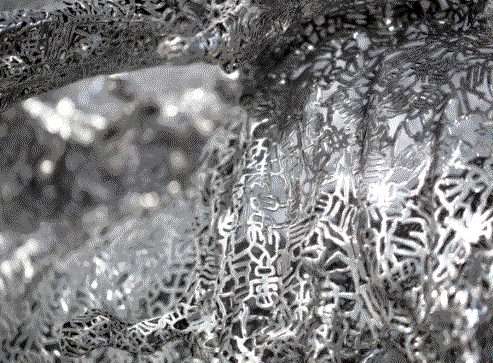
I'M FOND OF POETRY FOR ITS INHERENT SYLLABLES, TONES AND RHYTHMS, WHICH HAS A LARGE RESEMBLANCE TO PLASTIC ART. THEY BOTH ARE VERY FOCUSED WAYS OF REPRESENTING SOCIETY AND THE SPIRITUAL WORLD OF INDIVIDUALS WITH CONCISE EXPRESSION, PROFOUND EMOTION, AND DIVERSE FORMS. THIS IS WHY I'M VERY CONCERNED ABOUT THE CONCISENESS AND RHYTHM IN MY ARTISTIC LANGUAGE.' - ZHENG LU (IMAGE: DETAIL OF ZHENG'S WATER IN DRIPPING - CHAO, 2016)
All That Is Solid Melts into Air - On Zheng Lu's Sculpture
By Wu Hong
"Brushwork and ink-effect varies from time to time," said Shi Tao. This rule, however, seems to be very difficult to apply to sculpture, since material and techniques, in addition to modeling approach, do not change a lot with time. It involves collective identification throughout history about "sense of sculpture" as well which, as concept, is related to material and techniques, in addition to what is required by the modeling of a sculpture. If you criticize a painting for lack of "sense of painting", it might be your showing identification with challenging traditional aesthetics about painting; however, if you criticize a sculpture for lack of "sense of sculpture", you might be giving him a real slap on the cheek. The reason lies in the fact that what we mean by sense of painting is in fact traces of an artist's visible personal style, while the sense of sculpture refers to prototypal image of collective unconsciousness formed over time.
Sculptures in early times were mainly made of stone. Stone carving, with its hard and crisp material and limited processing techniques, led to our collective identification about a "work of sculpture" that, aesthetically speaking, stresses conglomeration, sense of volume, and global quality. Such identification, once growing into aesthetics about modeling, became the psychological prototype in this field. According to Michelangelo, when one pushes something off the mountain top, what remains is the sculpture. This legend, though with no historical proof, after being repeated and stressed by teachers to their students, one generation after another, became the golden rule for sculptors. What is hidden in the legend reveals our feeling of sacredness toward conglomeration, sense of volume, and global quality. Therefore, if you give rash comments by saying the sculpture lacks sense of sculpture, you are doing nothing less that killing the sculptor.
Traditional aesthetics about modeling has not changed very much despite the increased freedom in the form of expression due to the development in stone processing, metal casting, and, above all, metal welding since modern times. In his statement about aesthetics of sculpture modeling, Matisse, who had make revolutionary contribution to painting, once pointed out, "…the sculptor must feel, in making it, the particular demands for volume and mass. The smaller the bit of sculpture, the more the essentials of form must exist."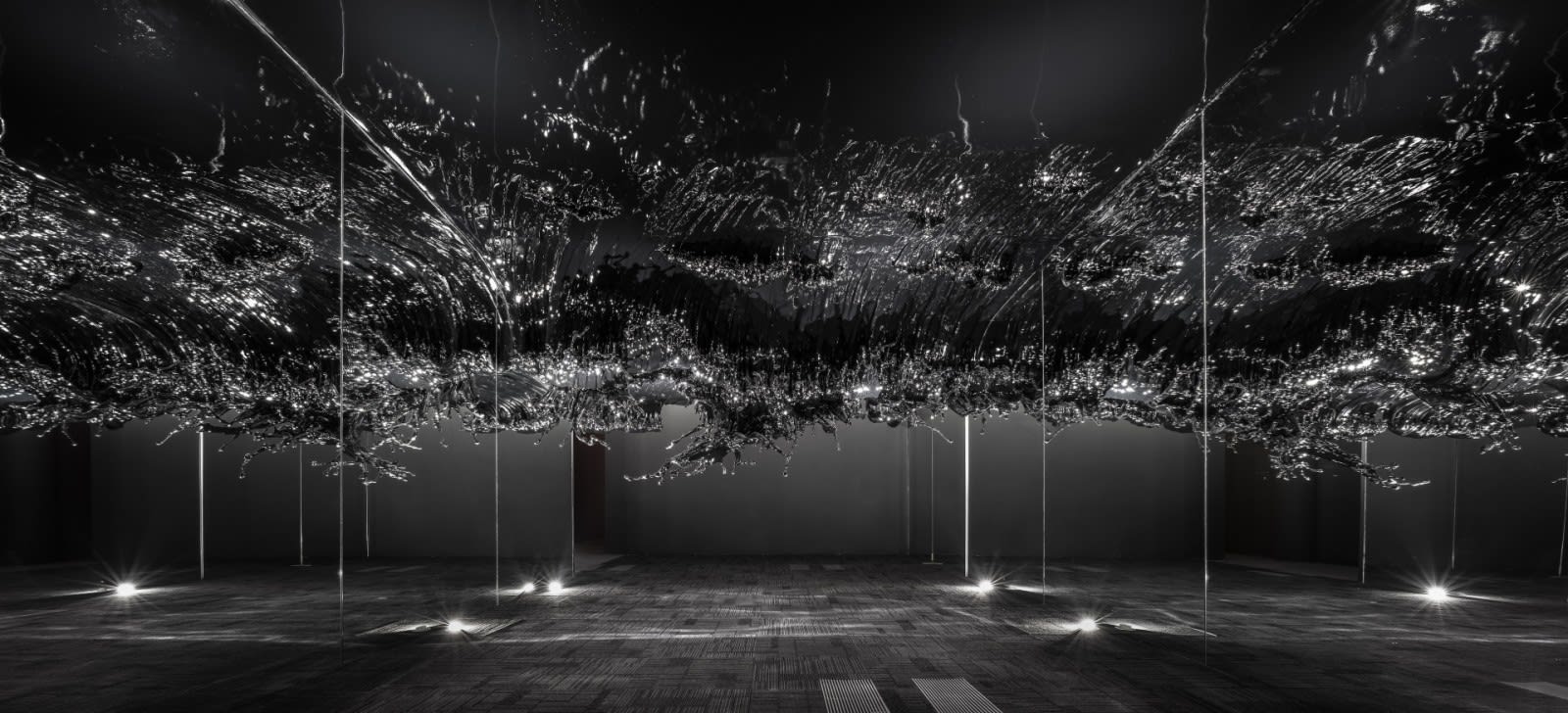
Zheng Lu, Shiosai, 2016, Stainless Steel, Lacquer, 500 x 410 x 280 cm
As far as western modern sculpture is concerned, after the gifted Picasso revolutionarily dispelled the myth about volume and mass of sculpture, and then Wesley Snipes, Archipenko, Zadkine, Barbara Hepworth, and Henry Moor advanced their understanding of "negative form" and "negative space", the substance that constitutes the so-called negative space is still wrapped in solid metal mess.
From the perspective of modeling aesthetics, Zheng Lu's works, however, counteract such sense of volume and mess in traditional sculptures. His motivation comes from his conversion of material from traditional Chinese calligraphy scrolls in his early life. After the metal gets character piercing treatment, the effect the property of the material on our psychology changed, and the heavy steel board become light and clear. What follows it the development of another "substance" from this dispelled "substance negative form". So, the effect of such "substance" has on us is multiple. Is it eternal or transient? Is it real or unreal? Is it deconstruction or construction? Is it three-dimensional or two-dimensional?
There was still a bit of volume and mess on the surface of the steel when he pierced and cut the board of certain thickness in the early time. In his recent works, however, the large quantity of thin stainless steel board dispelled to its maximum volume and mess of the material. The purpose behind this change in the choice of material is obvious: to present the paradox of "formless form".
The stainless steel as material helps to achieve such effect. The development in stainless steel sheet processing and welding technique makes it possible to introduce stainless steel in sculpture making for its tractility and inoxidability. In the last twenty years, in particular, with the movement of urbanization from the central government to the local one, the dominant ideology began to bring forward their own demand for the so-called "modernity", and therefore, this material of arts and crafts, cheap and easy to handle, becomes vulgarly overused in urban public sculptures. As to indoor shelf sculptures, however, except for some conceptual use of this material, we seldom see the modeling potential is fully developed and incorporated into the modeling of the work.
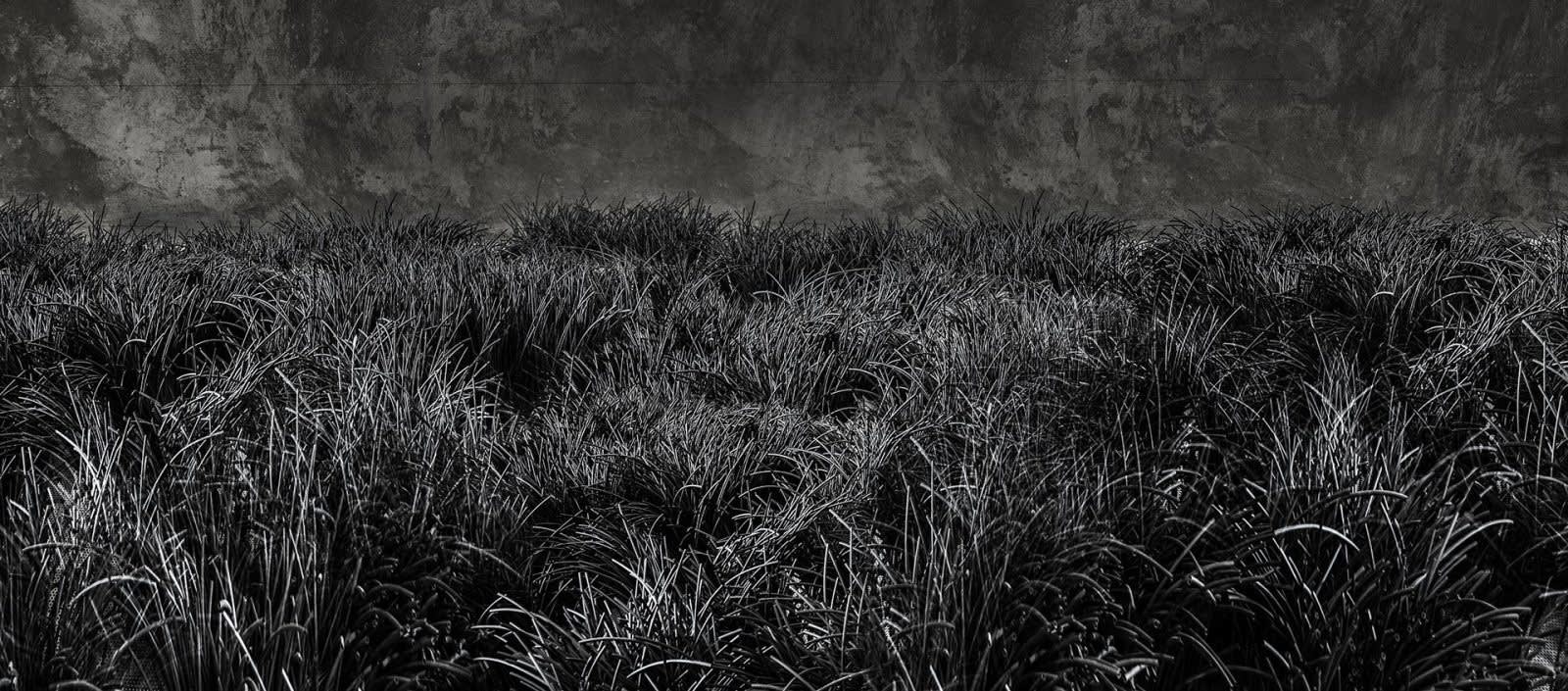
Zheng Lu, Grass, 2016, Iron Plate, Heat Shrink, Site-installation, Variable size
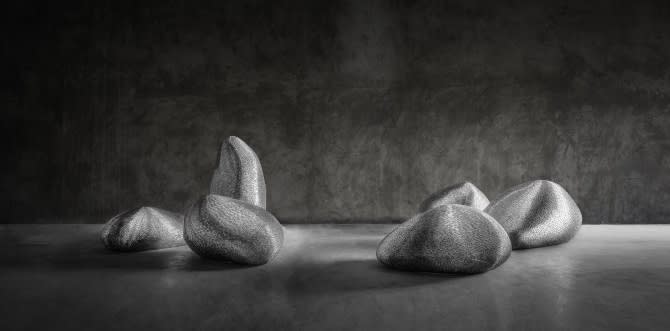
Zheng Lu, Almost Zen, 2012, Stainless Steel, Variable size
Balance has to be kept between the thickness and hardness to ensure that the artist is dealing with the thinnest board on the premise of the formal solidity. In the meanwhile, the stress form welded metal makes the visually fragmentary and broken surface extraordinarily hard. Therefore, dislocation on the level of psychology of vision is inevitable. Are they broken or intact? Are they contingent or necessary? Do they belong to appearance or to essence?
In addition, good post-processing performance of the stainless steel makes the polished surface clean and fine, clear and translucent, and the solidity of the volume are thus much weakened, which leads to new conflict between the empty space and fluid air in the volume and the "real essence" of the volume indicated outside.
Among Chinese sculptors, Zhan Wang is considerably skillful in handling stainless steel as material, but he takes material only as one perspective for his irony of artificial life philosophy in the industrial age. In Zheng Lu's works, material participates in modeling and extends to the reflection on modeling aesthetic system of traditional sculpture.
Therefore, we know how Zheng Lu aspires to define "nonexistence" with sculpture as medium. The concept of Nonexistence here differs from the exploration of "negative space" by modern western sculptors mentioned above in that "negative form" or "negative space" is still related to substance, "subtracted" substance, to be exact. The concrete object ceases to exist, but the space, volume, and mass "it" used to take remains. In Zheng Lu's works, however, "nonexistence" belongs to the realm of spirit, and is philosophical expression about world outlook. To summarize, his experiment, form modeling to the use of material, aims to achieve nothing more than his own voice in expressing his understanding of the outlook. As is said by Marx in The Communist Manifesto when describing the degradation in Western culture and morality, "All that is solid melts into air, and all that is holy is profaned."
Zheng Lu was born into a family rich in cultural heritage. The jobs several of his elders used to take all had something to do with words. Besides, judging from the poems his father wrote in his early years (which are included in Zheng Lu's works as well), we know it is an ideologically "orthodox" family. What's more, the training he received about sculpture was the most "orthodox", from his undergraduate years in Luxun Academy of Fine Arts to postgraduate years in China Central Academy of Fine Arts. The change may be attributed to his exchange study in Ecole National Supérieure des Beaux-Arts. I once attended a lecture by the dean of the Sculpture Department when he came to Beijing as an exchange scholar in China Central Academy of Fine Arts. He is specialized in multimedia installment, and his work has absolutely noting to do with the "traditional" concept about "sculpture". We can imagine what a shock it was to Zheng Lu's established values based on traditional aesthetics of sculpture.
We can thus come to a conclusion which may again take us into Zheng Lu's inner world-the perplexity might have tended towards "nonexistence" when what he received from his family, or from the "solid" values based on the specialized training got questioned, challenged and counteracted.
In our inner world, the most effective way to adapt ourselves to the external world tends to be searching for another force to strike a balance with the force we are facing through inner self-regulation. The material world keeps the equilibrium in this way, and it is true of the human psychological world to get inner peace. The way to inner equilibrium, to Zheng Lu, is to give something "that melts into air" a material form in his work, like an elegy, to reach the visual material "freeze shot" in the course of movement. In this sense, Zheng Lu's works are poetic and melancholic.
What is discussed about until now leads naturally to the conclusion that it is inevitable for Zheng Lu to turn to Chinese characters. It is of course due to the influence from his family, but another factor seems to be more decisive-words are equipped with "meaning".
Words are considered solidified forms of language and the material form of ideas. The way Zheng Lu makes use of words, therefore, is determined not only by modeling but also by "meaning", and words are merely the solidified material form of such "meaning". The dislocation we mentioned in his modeling and his use of material reveals his conflicting inner world about "meaning".
I like To My Father very much. The words are from his father's eulogy to Mao Zedong in his early years that imbues with the dominant values and emotive judgment. The words of this poem are organized in the form of a round Mao's badge. So what his work shows as the point where the "meaning" takes place is not the grand narratives about that age which have nothing to do with him in an immediate way. What interests him is how he inherited his father's the world outlook and values how he revolted against them. What seems absolutely right, unquestionable and "solid" spiritual tendency becomes "graceful", errant, transient, fragmentary visual image in his works.
His skeptic quest does not confine the object to his experience. The words he took form Declaration of Human Rights becomes another interpretation of the western universalism. As is known to all, "Declaration of Human Right" is the base of the western social values and its unquestionability gives it "divinity" in the western social value judgment. As to its idealization of the internal logical basis and the finiteness of the condition, people choose to be selectively oblivious, trying not to question the over-idealization of the logic. "All human beings are born free and equal in rights." This kind of "equality" in a stratified society that is about private ownership, and different classes, however, is only conditional and ideal. Such overidealized expression invariably leads to duality of actual standard for judgment. In Zheng Lu's works, this paradox is easily materialized with positive and negative character modeling.
"No thing is sharper than running water and no mirror is better than still water" (In Appreciation of Still Water by Bai Juyi). These characters comprise another work about the universal fluidity and stability, eternity and transience, materiality and spirituality, essentiality and phenomenality - theses are the basis of logic in our world outlook. Moreover, throughout history, the "primal question" whether these paired concepts are in binary opposition or complementary has become colorful "knowledge" phenomena from the perspectives of literature, philosophy and religion. The modeling language in some of Zheng Lu's works deal with these "primal questions" with reference to literary, philosophical and religious "knowledge phenomena".
Therefore, the inclusion of characters in Zheng Lu's works cannot be simply identified with mere verbal expression in the form of "inscription". On the contrary, the "meaning" of a word is connected with its "material" property in that "a word" is both the carrier of meaning and an element of modeling material. The unity of "form" and "meaning" is reflected in the materiality of a word. It is the "material" use of the word that highlights the conflict between the word's "readability" in its original sequence and its "unreadability" in the works.
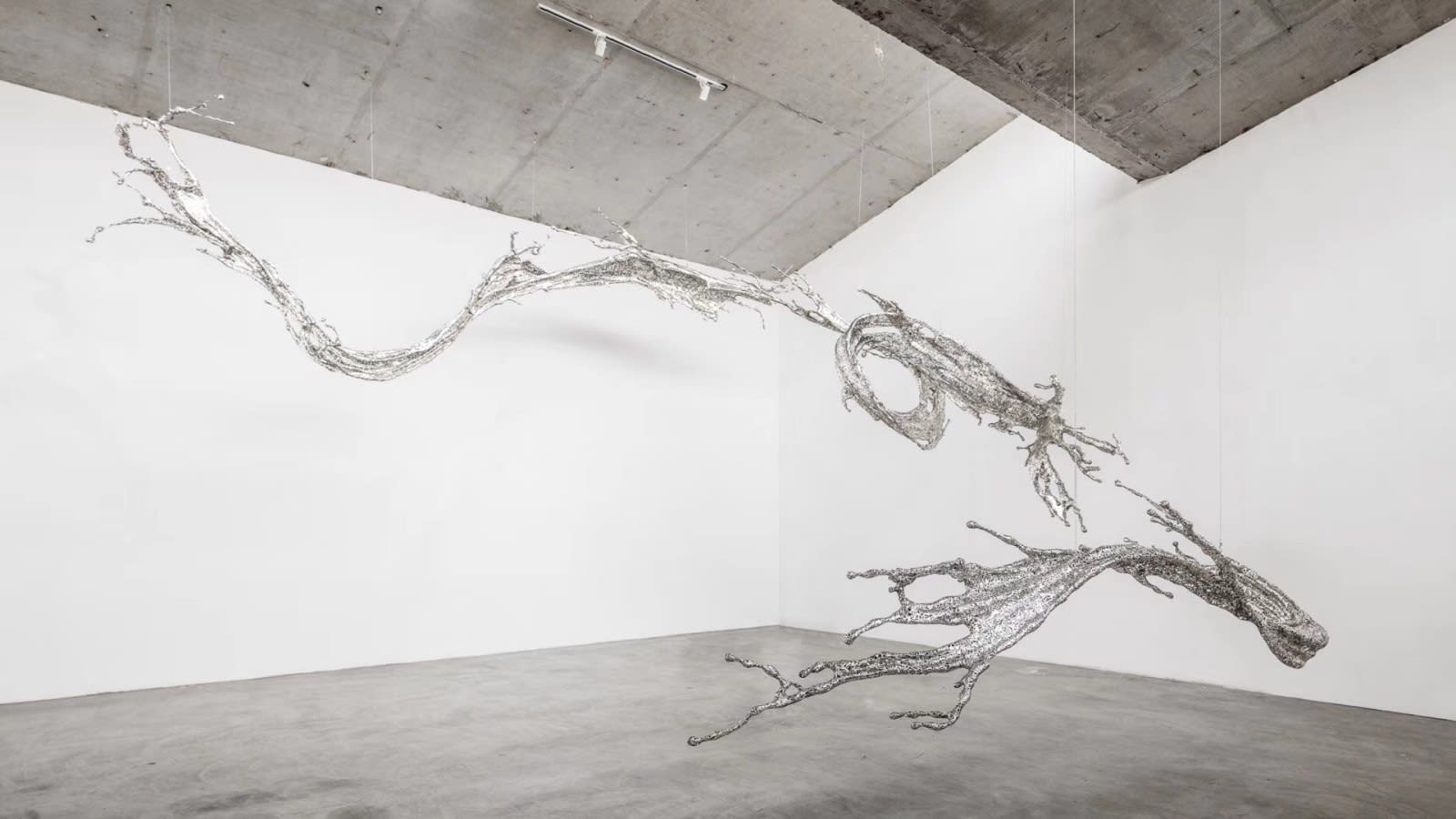
Zheng Lu, Whatever Journey It Takes, 2018, Stainless steel, 560 x 540 x 420 cm
We know that the stress on "context" is the basis of any discussion in linguistic study. A text becomes meaningless if it is isolated from its context or trapped in "vacuum". It is its meaninglessness that makes it possible for us to interpret it in different ways in different contexts. Not long ago the meaningless "Jia Junpeng, your mother wants you back home for meal" became exceedingly popular in cyberspace. Without a supporting context for its meaning, it became a game of language across the country. Different people put it into different contexts for different purposes. While subverting its contextual meaning, this event became a language spree in which "meaning" experienced limitless proliferation in different contexts. Psychologically speaking, it is a "participatory" spree, a textual spree in which "meaning" is shared through language.
The use of characters in Zheng Lu's works cannot be simply identified with mere verbal expression in the form of "inscription" because words in his works have their "original" sequence of meaning, and their "contexts" change when they become modeling elements in material form. In addition to material "modeling" elements, they are also language symbols whose "signifier" and "signified" change are in constant change. When it is a sequence in the meaning of "language", their meaning is established, but the meaning becomes chaotic and multiple when it is existence in the sense of "word" or "material". The conflict between stability and fluidity are thus elevated into the framework of linguistic discussion, more than modeling aesthetics and logics.
Unexpected Gift From Heaven, Double Car Crash and Elephant in a Peaceful Land are all works in this linguistic regard. The conflict between "pragmatical" meaning and modeling meaning becomes more evident. The "formal meaning" of "喜" ("happiness"), a particular Chinese folklore sign, as a modeling element, and its "pragmatical meaning" are contextually substitutive and opposite. "An elephant in a peaceful land", as one of the ten ancient auspicious patterns, features an elephant with a vase on back. The characters are from the words in Qian divinatory trigram in I Ching, which is the best among the total of 64. They express "peace". The image of an elephant carrying a vase, however, is turned into a precarious modeling found only in circus performance. In this case, the iconographic meaning of this work is just opposite to the linguistic meaning of this pattern of auspice. Here, the object (signified)→language symbol (signifier) is the first phase, which is about the abstract meaning of language; denotation (signifier) → symbolic meaning (signified) is the second phase in which the signified meaning is "delayed" and "mutated" when language is put into use. If we "play back", i.e., symbolic meaning →denotation, denotation →object,fallacy arises. This is an important principle of arbitrariness in Saussure's linguistics.
The characters in Impression of Hongren's Landscape Painting explain the technical term "vacuum coating", one of the techniques employed in the work. Words in the upper part are used only as modeling "material", but these "material" words in the lower part are treated with "vacuum coating", so words become "language" material with directive function of symbols. In this case, the work reveals vividly and artistically that there is not always a connection of necessity between the material form of the word (signifier) and its meaning form (signified).
Again, from what Li Daoyuan wrote in The Original Preface to Commentary to the River Classics, "Water is the most abundant matter in the universe…even learned scholars cannot reach its depth or understands its mystics", we know "water", in his understanding, like "the Way", follows the rule that "the names that can be named are not unvarying names". It does not have a regular form or remains in the same place and its ultimate knowledge is beyond human intellect. Water in Dripping, however, gets a solidified form after being "materialized", and the solidified material is exactly the words interpreting the mystified passage about water in The Original Preface to Commentary to the River Classics by Li Daoyuan. The material form of words is again detached from the meaning form.
When Zheng Lu once asked me earnestly in a talk if his works could still be called "sculptures', I told him it was not a problem as long as it is an "excellent" work. The material, the technique and space involved in a sculpture facilitate the transition form a sculptor to an installation artist, but, in turn, the aesthetic modeling features of sculpture, formed over a long time under the influence of material and space in sculpture making, will be a handicap to a sculptor who wants to make breakthroughs in modeling. When talking about feet-crossing Maitreya in the thirteenth grotto in Yungang Grottoes, many people are amazed by the figure of a strong man standing between Maitreya's left arm and left leg, with one arm overhead holding Maitreya's gigantic hand. They are impressed by its exquisite modeling. As a matter of fact, it is only about adjustment in modeling due to the material's physical property. Therefore, it seems only natural for an appropriate style of modeling to come into being when material and processing technique fit. Zheng Lu's progress based on his creativity in the use of sculpture language is in line with the evolution of sculpture.
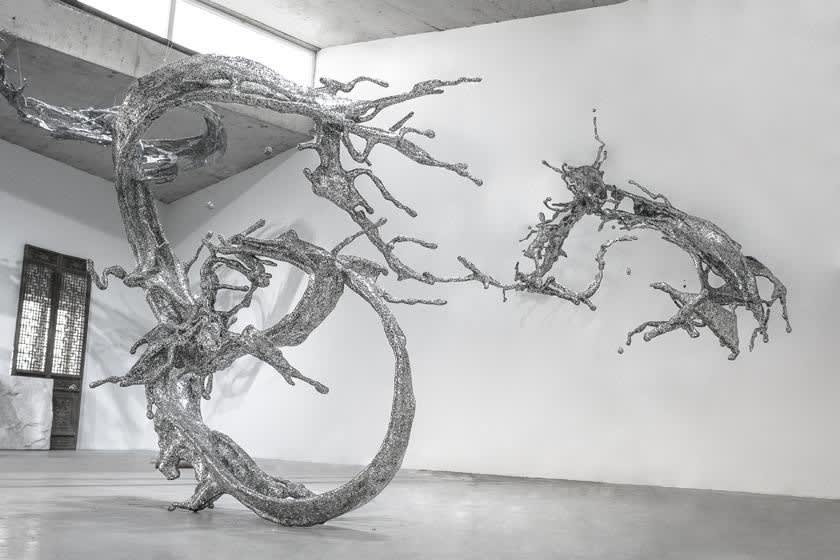
Zheng Lu, Water in Dripping - Splashing, 2014, Stainless steel, 322.6 × 482.6 × 863.6 cm
In summery, by incorporating in his works new material and new techniques, Zheng Lu deconstructs the established standard about volume, mass and tension of form in the modeling aesthetics about traditional sculpture, introduces the Eastern concepts of "nonbeing" and "nothingness" as modeling language and, further, diversifies the aesthetic modeling techniques in making sculptures. Moreover, based on his understanding of linguistics, particularly the relationship between "language" and "word", "signifier" and "signified", he introduces "word", in categories of "material" and "language" respectively, into sculpture modeling and semantic logics. In his artistic representation of the dualistic relationship of unity and contradiction between the two categories, he reinterprets the convention or law, thus motivating the viewer to participate and interact both on the level of "form" and of "meaning".
Early morning, August 20, 2009
Tongzhou, Beijing

